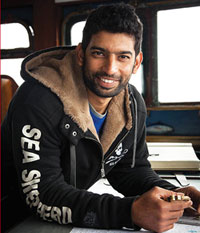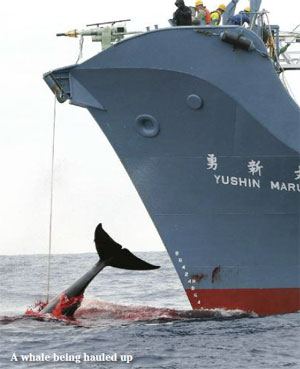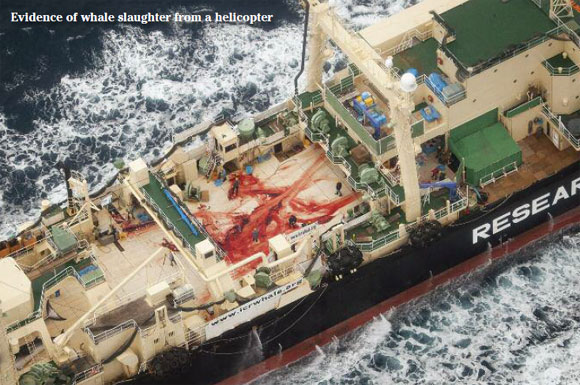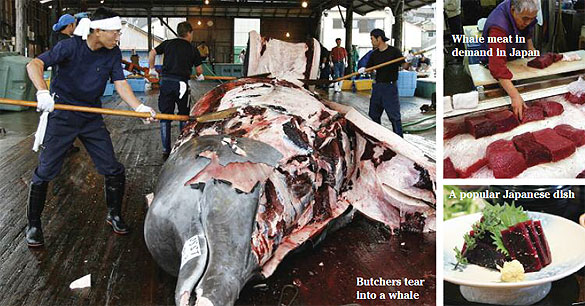|

Siddharth Chakravarty
Captain of The Steve
Irwin, Siddharth Chakravarty, has been at the helm of The Steve Irwin, one of the conservation vessels that moves around in the waters of the Great Whale Sanctuary in the Southern Ocean. Grandson of a sailor, Chakravarty likes to read up and see films. The last book read was “The Immortals of Meluha”, the last film seen was “Forbidden Ground Fukushima” at the Uranium Film Festival at Mumbai in 2014. He spoke to
India Empire about his dauntless excursions into the Southern Ocean
|
|
 As captain of The Steve Irwin, please give us a feel of what it is like being in the Southern Ocean—the ‘Furious Fifties’ and the ‘Shrieking Sixties’ must be difficult sea terrain as well as a tough climatic zone to be navigating in, let alone keeping whaling intruders at bay? As captain of The Steve Irwin, please give us a feel of what it is like being in the Southern Ocean—the ‘Furious Fifties’ and the ‘Shrieking Sixties’ must be difficult sea terrain as well as a tough climatic zone to be navigating in, let alone keeping whaling intruders at bay?
The journey south from Australia is always one of excitement and with a sense of new found innocence. Nothing that exists in the Southern Ocean is found anywhere else in the world, be it the life that exits there, or the oceanic landscape The 40s and the 50s are always the latitudes where ships gets rocked like little dinghies, swaying to the force of nature. Once past those belts though, far away from human civilisation, nature continues to play out its delicate balance. To be entering an unforgiving and harsh environment fills me with awe and wonder, while at the same time reminding me of my own vulnerability.
What motivated you to opt for a career with Sea Shepherd?
Anyone who wants to live in harmony with the planet, or has experienced the wonder and joys of nature, is pushed to act when they see the destruction around them. I spent 10 years working on commercial ships, and when I realised that I could use my skill to safeguard the future of this planet and the oceans, I immediately opted for Sea Shepherd. Cities are nothing but concrete jungles that are choking everyone. The real beauty in living is to experience nature in its most pure form. That for me is motivation enough.
What is your background—where did you grow up, and train to navigate ships?
I was born in Bhopal in 1983 and was 6 months old when the Bhopal Gas Tragedy happened. I lived there for another 6 years before moving to Nasik in Maharashtra. I trained to go to sea while I was still 17 and a few days after turning 18, I was away. I worked on different types of ships before settling for chemical tankers. However being born in Bhopal and having heard first-hand about the disaster of the gas leak, I soon realised that I needed to move on. I sent in an email to Sea Shepherd Conservation Society and now I find myself working full time with the organisation.

Tell us about some of the “close shaves” you had with the Japanese whaling fleets…
Sea Shepherd operates on the principle of "non-violent direct action". What we do is that we place our ships in the midst of the illegal whaling operations and disrupt the hunt. This has successfully driven the whaling fleet into financial losses and our premise is to sink them financially. However, this also means that the whalers have turned to be more aggressive and are trying hard to protect their sinking industry. Over the last 3 campaigns, my ships have been rammed by a factory ship about 8 times the size of my vessel. This year my ship was attacked by 3 harpoon ships, a total number of 45 times. In the past, one of our ships has been sunk as well. It is the price we pay to stand strong and confront the whale poachers. The Steve Irwin is a 60 meter ex-Scottish Fisheries Patrol Vessel. We've had her for 8 years now. She was built in 1974. The Nisshin Maru is the Japanese factory ship which is used for butchering the whales. It's a former deep-sea trawler converted to her current job. She has been built in 1972.

Why do you feel so strongly for the cause of whales?
Sea Shepherd has led campaigns all across the world's oceans for different species as well. From being on campaigns saving Blue Fin tuna in the Mediterranean to the sharks in the South Pacific, I have led and captained ships on various other campaigns. However the poaching is inside a whale sanctuary and is completely illegal. Just recently, the International Court of Justice has delivered a verdict that Japan must end its hunt immediately. Sea Shepherd has been saying this time and again through our decade of campaigning to uphold the sanctity of the Southern Ocean Whale Sanctuary.
Do you receive enough support from Governments around the world for the kind of tireless voluntary work that you do?
The truth is that until now very few Governments have voiced their support for Sea Shepherd. We have very often done the dirty work for the governments. For example the governments of Australia and New Zealand claim territory in Antarctica but though whaling is illegal in their countries and their waters, they have done nothing to stop the whale poachers from operating there. Had it not been for Sea Shepherd, over 10,000 whales would have been killed, as opposed to the 3,500 that the whalers have roughly got. That being said, Sea Shepherd has recently formed alliances with the governments of Senegal and Guatemala to patrol their waters for them.
Could more be done by Governments, and if so, how?
Good laws exist to safeguard the oceans. However the cost of patrols is deemed to be too much by most countries. The constituents and the governments need to realise that we do not live on this planet without having a healthy and functioning ocean. Our life hinges on the state of the oceans. Governments need to first begin patrolling their waters, set massive fines for offenders and ensure that poachers are literally scared to fish in these waters. Additionally revoking fishing licenses and reducing the number of fish being caught annually is an urgent need of the hour. We're literally emptying the oceans and somehow being out of sight and therefore out of bounds, it is deemed to be okay and sustainable.
Getting support and raising resources for such daunting operations must be challenging. How does Sea Shepherd reach out to the people, and convince them of providing support for protecting whales in a very remote part of the world?
Sea Shepherd does not believe is canvassing or holding posters and forcing people to sign up. Sea Shepherd believes in delivering the result and thereby attracting interested people. Over the last 37 years, we have grown for one reason alone and that is that we're extremely effective. When we set a goal we achieve it and this attracts caring and passionate individuals who want to be a part of the movements to protect the oceans.
In terms of water mass, how large is the Whale Sanctuary?
The Whale Sanctuary covers an area that is roughly 5 million square miles. However whaling occurs in only half of this region, only by the Japanese Whaling Fleet.
In terms of stretching one’s sailing endurance and skills, what according to you is the most difficult or hostile spot in the Southern Ocean?
I would reckon that the most hostile spot and time in the Southern Ocean is the month of March. By that time we're already at sea for over 2 months, which means that exhaustion is setting in. However it also is the time when winter sets in which means the temperatures plummet and the ice begins to form fast. It is also the time when the 40s and the 50s become very hostile latitudes to be in. From avoiding being caught in the forming ice to lasting through the rough weather, March is the time when our endurance is really tested.
|